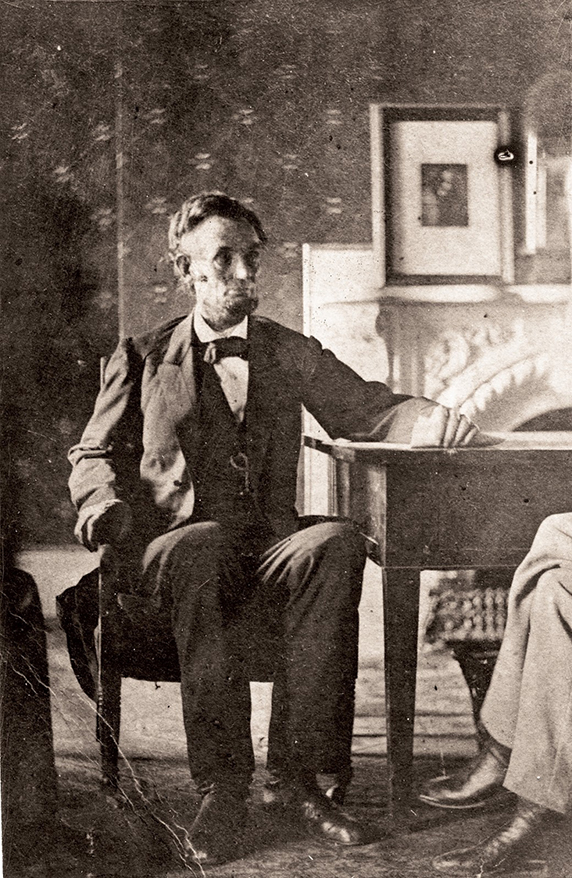Stevens Hall at Gettysburg College, as it appeared in the 1880s. The college observatory (no longer standing), can be seen in the left of this photograph.This image was taken facing southwest by William Tipton circa 1880s.
We’re standing on the sidewalk along the Carlisle Road by the Pennsylvania Museum and Historical Commission sign to Gettysburg Hall of Fame baseball player Eddie Plank. Plank’s house is located out of sight on the opposite side of the street from the marker. Stevens Hall is in the right background.This image was taken facing south at approximately 10:30 AM on Tuesday, January 17, 2017.
Stevens Hall was named after Pennsylvania Congressman and abolitionist, Thaddeus Stevens. His iron works were burned by Confederate Major General Jubal Early in 1863.This image was taken facing west at approximately 10:30 AM on Tuesday, January 17, 2017.
We were last here in 2011 to show you a newly installed wayside to Stevens and Stevens Hall. It could use a scrub. The wayside mentions that Stevens, a staunch abolitionst, was “an early advocate of the Emancipation Proclamation.”This image was taken facing west at approximately 10:30 AM on Tuesday, January 17, 2017.
We suppose that is why the college accepted a donation of yet another Gettysburg statue to Abraham Lincoln. Yeah, because we didn’t already have enough of those.This image was taken facing west at approximately 10:30 AM on Tuesday, January 17, 2017.
This is another example of a “seated Lincoln” statue.This image was taken facing west at approximately 10:30 AM on Tuesday, January 17, 2017.
It was installed on September 18, 2015, by the local Codori Memorials. Utah artist Stan Watts designed the statue.This image was taken facing west at approximately 10:30 AM on Tuesday, January 17, 2017.
It depicts Abraham Lincoln signing the Emancipation Proclamation, a presidential proclamation and executive order that would free slaves in the Confederate states in territories occupied by Union armies after January 1, 1863.This image was taken facing west at approximately 10:30 AM on Tuesday, January 17, 2017.
Lincoln read the preliminary draft of the Emancipation Proclamation to his cabinet on September 22, 1862, five days after the Battle of Antietam. This painting, “First Reading of the Emancipation Proclamation by President Lincoln,” was done by Francis Bicknell Carpenter in 1864.
Secretary of State William H. Seward and Assistant Secretary of State Frederick W. Seward took the official copy of the Emancipation to Lincoln’s office around noon on January 1, 1863. Lincoln signed the proclamation in his office. This photograph depicts Abraham Lincoln sitting at his desk in 1863 and is courtesy of the Keya Morgan collection.
Lincoln’s office served as his cabinet room. The room is today known as the “Lincoln Bedroom,” and was redesigned in the 19th century style under the presidency of George W. Bush. This photograph shows the northwest corner of the room as it appeared in 1889.This 1889 view of the northwest corner of the room shows the Lincoln-period mantel in detail and is courtesy of the Library of Congress.
The statue was shipped from Salt Lake City, Utah, to Gettysburg.This image was taken facing south at approximately 10:30 AM on Tuesday, January 17, 2017.
Artist Stan Watts took two years to complete the statue.The Carlisle Road is in the left background. The college is currently renovating and expanding the “Eisenhower House,” which you can see in the right of frame. This image was taken facing south at approximately 10:30 AM on Tuesday, January 17, 2017.
Watts told the Evening Sun that “this is probably the most important piece I have done.” The bronze statue “[honors] Lincoln because he did the hard task. He freed the slaves.”This image was taken facing southwest at approximately 10:30 AM on Tuesday, January 17, 2017.
The quote on the rear of the statue’s base comes from a letter Abraham Lincoln wrote to George Edward Pickett in 1842. Pickett was appointed to West Point by one of Lincoln’s law partners, and received a letter with advice from Lincoln shortly thereafter. Pickett would finish last in the West Point Class of 1846, a distinction also shared by his cousin Henry Heth, who finished last in his West Point Class of 1847.This image was taken facing east at approximately 10:30 AM on Tuesday, January 17, 2017.
The quote on the statue was modified to exclude Lincoln’s reference to drunkards. The actual quote in full reads: “The one victory we can ever call complete will be that one which proclaims that there is not one slave or one drunkard on the face of God’s green earth.”This image was taken facing east at approximately 10:30 AM on Tuesday, January 17, 2017.
















